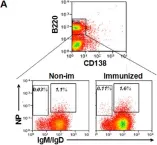Age-related decline in the ability of bone marrow (BM) to recruit transplanted hematopoietic stem and progenitor cells (HSPCs) limits the potential of HSPC-based medicine. Using in vivo imaging and manipulation combined with integrative metabolomic analyses, we show that, with aging, degradation of non-neurogenic acetylcholine disrupts the local Chrm5-eNOS-nitric oxide signaling, reducing arterial dilation and decreasing both BM blood flow and sinusoidal wall shear stress. Consequently, aging BM microenvironment impairs transendothelial migration of transplanted HSPCs, and their BM homing efficiency is reduced, mediated by decreased activation of Piezo1. Notably, pharmacological activation of Piezo1 improves HSPC homing efficiency and post-transplant survival of aged recipients. These findings suggest that age-related dysregulation of local arteries leads to impaired HSPC homing to BM by decreasing shear stress. Modulation of these mechanisms may improve the efficacy and safety of clinical transplantation in elderly patients.
© 2025. The Author(s).
Product Citations: 60
In Nature Communications on 1 July 2025 by Morikawa, T., Fujita, S., et al.
In Haematologica on 1 April 2025 by Trifinopoulos, J., List, J., et al.
Despite major therapeutic advances in the treatment of acute lymphoblastic leukemia (ALL), resistances and long-term toxicities still pose significant challenges. Cyclins and their associated cyclin-dependent kinases are one focus of cancer research when looking for targeted therapies. We discovered cyclin C to be a key factor for B-cell ALL (B-ALL) development and maintenance. While cyclin C is not essential for normal hematopoiesis, CcncΔ/Δ BCR::ABL1+ B-ALL cells fail to elicit leukemia in mice. RNA sequencing experiments revealed a p53 pathway deregulation in CcncΔ/Δ BCR::ABL1+ cells resulting in the inability of the leukemic cells to adequately respond to stress. A genome-wide CRISPR/Cas9 loss-of-function screen supplemented with additional knock-outs unveiled a dependency of human B-lymphoid cell lines on CCNC. High cyclin C levels in B-cell precursor (BCP) ALL patients were associated with poor event-free survival and increased risk of early disease recurrence after remission. Our findings highlight cyclin C as a potential therapeutic target for B-ALL, particularly to enhance cancer cell sensitivity to stress and chemotherapy.
-
Cancer Research
-
Cardiovascular biology
-
Immunology and Microbiology
A broadly applicable protein-polymer adjuvant system for antiviral vaccines.
In EMBO Molecular Medicine on 1 June 2024 by Wang, C., Geng, Y., et al.
Although protein subunit vaccines generally have acceptable safety profiles with precise antigenic content, limited immunogenicity can lead to unsatisfactory humoral and cellular immunity and the need for vaccine adjuvants and delivery system. Herein, we assess a vaccine adjuvant system comprising Quillaja Saponaria-21(QS-21) and cobalt porphyrin polymeric micelles that enabling the display of His-tagged antigen on its surface. The nanoscale micelles promote antigen uptake and dendritic cell activation to induce robust cytotoxic T lymphocyte response and germinal center formation. Using the recombinant protein antigens from influenza A and rabies virus, the micelle adjuvant system elicited robust antiviral responses and protected mice from lethal challenge. In addition, this system could be combined with other antigens to induce high titers of neutralizing antibodies in models of three highly pathogenic viral pathogens: Ebola virus, Marburg virus, and Nipah virus. Collectively, our results demonstrate this polymeric micelle adjuvant system can be used as a potent nanoplatform for developing antiviral vaccine countermeasures that promote humoral and cellular immunity.
© 2024. The Author(s).
-
Biochemistry and Molecular biology
-
Immunology and Microbiology
Conserved role of hnRNPL in alternative splicing of epigenetic modifiers enables B cell activation.
In EMBO Reports on 1 June 2024 by Subramani, P. G., Fraszczak, J., et al.
The multifunctional RNA-binding protein hnRNPL is implicated in antibody class switching but its broader function in B cells is unknown. Here, we show that hnRNPL is essential for B cell activation, germinal center formation, and antibody responses. Upon activation, hnRNPL-deficient B cells show proliferation defects and increased apoptosis. Comparative analysis of RNA-seq data from activated B cells and another eight hnRNPL-depleted cell types reveals common effects on MYC and E2F transcriptional programs required for proliferation. Notably, while individual gene expression changes are cell type specific, several alternative splicing events affecting histone modifiers like KDM6A and SIRT1, are conserved across cell types. Moreover, hnRNPL-deficient B cells show global changes in H3K27me3 and H3K9ac. Epigenetic dysregulation after hnRNPL loss could underlie differential gene expression and upregulation of lncRNAs, and explain common and cell type-specific phenotypes, such as dysfunctional mitochondria and ROS overproduction in mouse B cells. Thus, hnRNPL is essential for the resting-to-activated B cell transition by regulating transcriptional programs and metabolism, at least in part through the alternative splicing of several histone modifiers.
© 2024. The Author(s).
-
Genetics
-
Immunology and Microbiology
Enrichment of liver MAIT cells in a mouse model of Alzheimer's disease.
In Journal of Neuroimmunology on 15 May 2024 by Wyatt-Johnson, S. K., Kersey, H. N., et al.
Emerging evidence has supported a role for the immune system and liver in Alzheimer's disease (AD). However, our understanding of how hepatic immune cells are altered in AD is limited. We previously found that brain mucosal-associated invariant T (MAIT) cell numbers are increased in AD. Furthermore, loss of MAIT cells and their antigen-presenting molecule, MR1, reduced amyloid-β accumulation in the brain. MAIT cells are also significantly present in the liver. Therefore, we sought to analyze MAIT and other immune cells in the AD liver. Increased frequency of activated MAIT cells (but not conventional T cells) were found in 8-month-old 5XFAD mouse livers. Therefore, these data raise the possibility that there is a role for peripheral MAIT cells in AD pathology.
Copyright © 2024 Elsevier B.V. All rights reserved.
-
Immunology and Microbiology
-
Neuroscience
In NPJ Vaccines on 19 February 2019 by Andersen, T. K., Huszthy, P. C., et al.
Fig.7.B

-
FC/FACS
-
Mus musculus (House mouse)
Collected and cropped from NPJ Vaccines by CiteAb, provided under a CC-BY license
Image 1 of 2
In Sci Rep on 16 May 2016 by Liu, C., Richard, K., et al.
Fig.1.A

-
FC/FACS
-
Collected and cropped from Sci Rep by CiteAb, provided under a CC-BY license
Image 1 of 2

